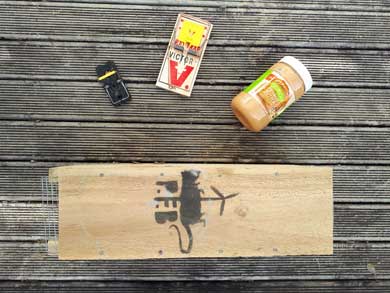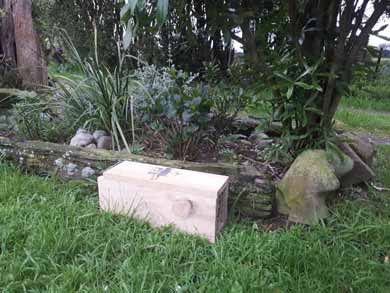Trap predators in your backyard
Introduction
One of the best ways you can look after the native birds and lizards in your backyard is by protecting them from rats and mice.Trapping protects native animals
Native animals are returning to urban areas around New Zealand as DOC, restoration groups and councils protect more and more reserves by removing introduced mammals such as rats and mice. But wildlife do not recognise reserve boundaries and happily visit private gardens for the food they find there.
You can ensure native birds and lizards are safe when they visit your home by trapping predators on your land. If everyone puts one or two covered rat traps in their garden, the number of native animals will increase and you'll be able to enjoy more birdlife in your garden.
The easiest way to start trapping is to find your nearest predator control group. Many community groups throughout the country are carrying out predator control and can provide advice to help you get started.
Find your local groups with the Predator Free NZ map.
How to trap in your backyard

Top: mouse trap, rat trap, peanut butter. Bottom: trapping tunnel
What you'll need
- A mouse trap
- A rat trap
- A trapping tunnel (also known as a trap box)
- Peanut butter
- An outdoor area to put your trap
If there is a Predator Free community near you, they may have trapping tunnels available, or you can build the tunnel yourself.
You can get the traps from these sources:
How to set your trap
1. Place the rat tunnel beside your bank or wall and open the door, ready to insert your traps.
2. Put a teaspoon of peanut butter into the rat and mouse traps, and set them.
3. Slide your rat trap into the tunnel with the step plate facing away from your hands (ie facing the tunnel entrance), then slide the mouse trap in behind it. Try to keep the traps near to the back of the tunnel where you are sliding them in. If they are clear of the entrance to the tunnel there is less risk of snapping curious pets or children's fingers.

Trap set at the edge of the garden where rodents are more likely to be running
Image: DOC
Where to put your trap
Rats and mice don’t like to run across big open areas like lawns, and instead tend to stay near the cover of plants of buildings. This means that a good place to put your trap is beside a wall or bank, as the rats and mice are likely running along here.
How often to check your trap
Have a look inside every day or two for the first couple of weeks to get an idea of how many mice and rats are around.
Keep checking every few days if you're finding you're catching quite a few, but if you find you're not seeing many you can reduce your checks to once every week or two.
Make sure you keep your bait fresh as well, replacing it and cleaning your trap every month or so.
What to do with the rats and mice you catch
This is up to you, but we recommend either burying them in the garden or putting them in the rubbish, wrapped up if your rubbish day is a while away.
Tips for backyard trapping
Choose the best bait
This is a widely disputed issue, with some trappers swearing by peanut butter, while others buy rodent bait from specialist retailers.
Researchers at Victoria University of Wellington have put the different baits to the test, and found that wild rats prefer cheese, milk chocolate, Nutella and walnuts to standard peanut butter.
Offer some ‘free’ bait
Put a bit of ‘free’ peanut butter in the tunnel in front of the trap – this encourages the rats and mice in. It helps attract more rodents too, as they’ll return to their nest with the first haul of peanut butter, and then bring their family back to the trap for more.
Put your trap in a prime location
It might be tempting to put your trap into the middle of your garden. This isn't necessarily the most effective position though, as rodents tend to avoid big open spaces.
Rats and mice prefer to run close to walls, plants and fences where they're hidden from keen cat eyes. So the best place for your backyard trap is beside a wall or fence where the rats might be running.
And if the first location fails, try again
If you don’t have a wall/fence to put your trap beside, or you’re not catching much, think about where in your garden the rats and mice might be hanging out.
Rodents will be attracted to places where they can find food and water. If you have a compost heap or trees that drop fruit on the ground your resident rats will probably be spending some time there, so that’s a good spot for your trap. Another good place is beside a waterway if you have one as rats and mice tend to run alongside streams and creeks.
Get your neighbours involved
If you reach a trapping plateau and stop catching as many rats and mice as you used to, it could be because they've cottoned on to that fact that your yard isn't safe. They could be seeking sanctuary in properties nearby instead, so getting your neighbours involved in trapping will help ensure your entire neighbourhood is protected.
Then, next time you reach a plateau it may well be because you’ve caught the lot!
What else can you do?
- Allow lizards to use your buildings, garden plantings and firewood piles for homes.
- Diverse gardens are a great food source for native birds and insects.
- A 'messy' garden is good for wildlife such as lizards. Rank grass and thick plantings are much better than large expanses of short, mowed lawn.
- Be a responsible cat owner: microchip and neuter your cat and know where your cat is.
- Encourage your neighbours to trap rats and have wildlife friendly gardens.
- Find out more about attracting birds and lizards to your garden.
- Minimise the use of sprays, which will kill native invertebrates, and the food source for many native birds and lizards.
Disposing of predators
It is an offence under the Animal Welfare Act 1999 to use any inhumane methods to dispatch of predators.
Approved methods for dispatching of predators using kill traps are outlined in our Predator Free 2050 trapping guide. All of these traps have been approved by the National Animal Welfare Advisory Committee and comply with The Animal Welfare Act 1999.
